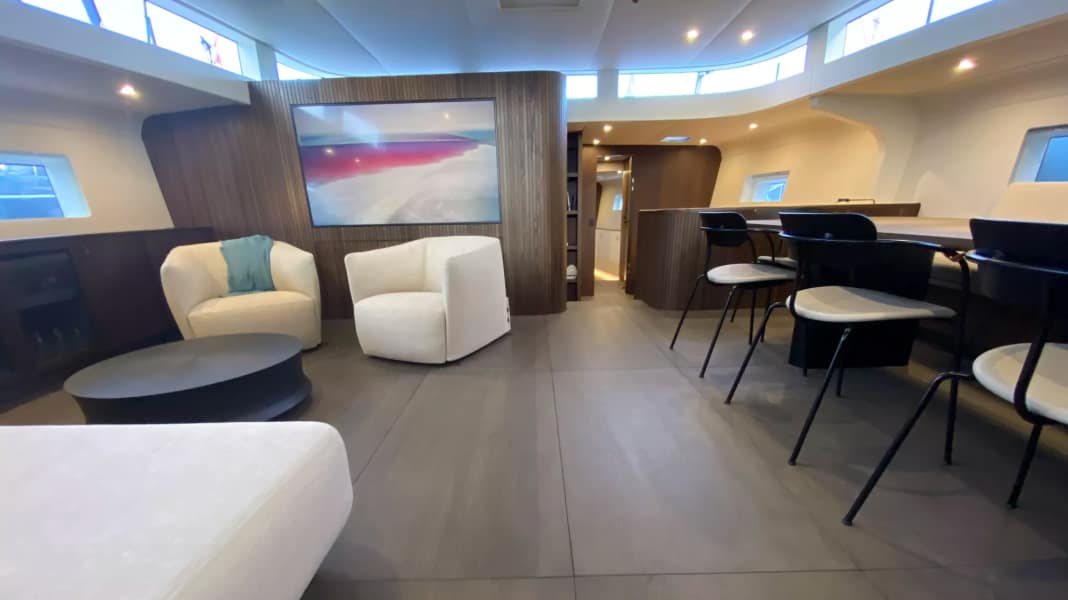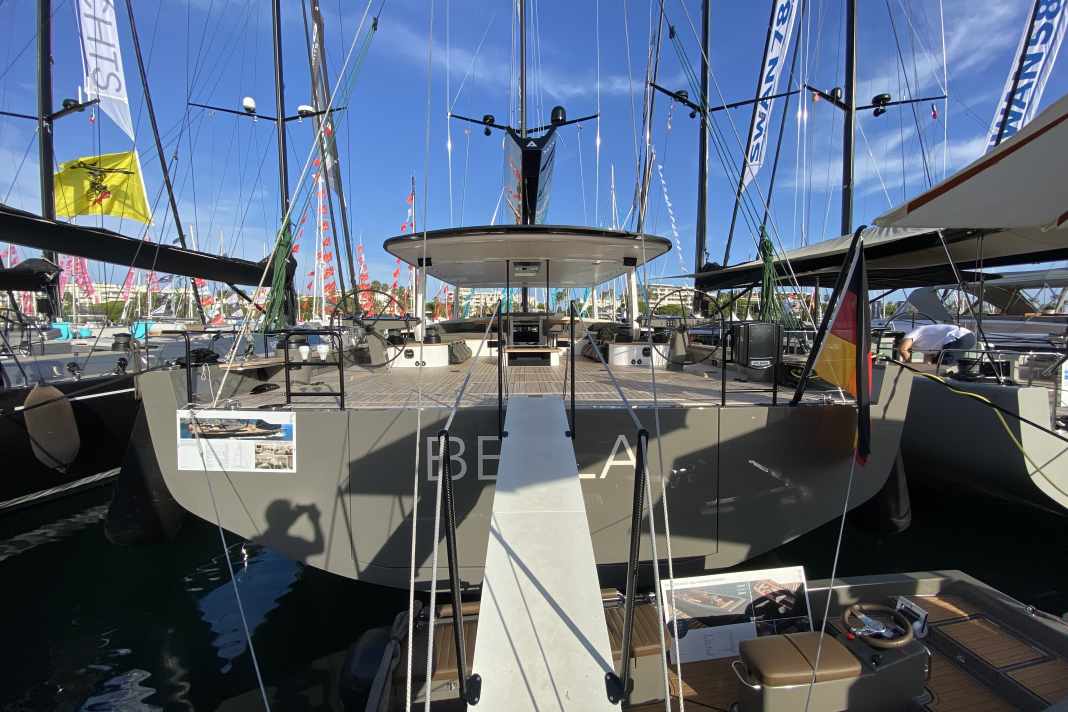
The Yachting Festival Cannes is currently drawing to a close with a mixture of restrained joy and calm amazement. It was, once again, a trade fair of superlatives - not only because of the glamorous backdrop of the French Riviera, the summer temperatures or the astonishing number of large-format world premieres in particular, which we have already reported on in extracts and will continue to do so in the coming days.
The subtext of the event was almost more astonishing. At any rate, the statements from the shipyards across all sectors can be summarised as saying that the threat of inflation and the foreseeable energy shortages caused by the Russian sanctions as a result of the war in Ukraine have hardly had any noticeable impact to date. On the contrary, boatbuilders are unanimously reporting a continuing stable, and in some cases even increasing, level of incoming orders.
Whether catamarans, performance cruisers or cruising boats - demand remains high and delivery times long. At Outremer, for example, owners who order the 55 performance catamaran that won Europe's Yacht of the Year today will have to wait until 2025. Shipyard boss Xavier Desmarest is therefore even planning to expand capacity in the medium term - as is Nautor Swan, which will hardly be able to deliver new orders before 2024 and will reach the record volume from the previous year again in 2022.
Even if here and there something like disbelief mingles with the commentary on the continuing good business development, when quiet concerns are expressed about the inevitable further rise in prices - there was no talk of a stall in the sailboat market anywhere in Cannes.
After the coronavirus boom of recent years, it seems that fears of inflation and a feeling of not wanting to wait any longer have now become sales drivers, along with a noticeable trend, particularly in the multihull segment, of increasingly using boats as holiday (im)movables. World market leader Beneteau speaks openly of "real estate on the water"; competitor Fountaine Pajot prices its catamarans more on the basis of square metres of living space than sail area. Something is shifting there too.
High-tech from Greifswald - on board the largest new sailing yacht in Port Canto, the Y9
Michael Schmidt, founder of Hanseyachts and who returned to boatbuilding a little later with Y Yachts after leaving the company, this time in the luxury class, is going his own way - that of a high-end carbon fibre manufacturer. And he is also benefiting from the never-ending economic boom. Within a short space of time, he has successfully established himself and his brand in a niche beyond Baltic, Nautor and Southern Wind from his base in Greifswald.
His 90-foot Y9 set the standard for sailing world premieres in Port Canto. No other surpassed it in length - and in extravagance.






In fact, the Bill Tripp design is unique in every respect. More reduced in its formal language, more harmonious in its design, more astonishing in its effect, more radical in its use of carbon fibre technology, more imaginative in its details. And you have to travel here to experience it live and in 3D. The equally beautiful and multifaceted Website of the model gives a good first impression, but can only partially reflect the unique position of the previous Y flagship.
Anyone wishing to climb the 6.80 metre wide and two metre high stem did so via the carbon passarelle, which is obligatory in such spheres and which acted as a bridge over the tender moored aft. And that's where the special features begin.
So please forgive the brief digression about the dinghy. It is obligatory here. Like the mother ship, the Y-tender is made of carbon fibre and weighs only 170 kilograms without the engine at a length of 3.70 metres. And it is no ordinary RIB. Rather, two hulls give it cat-like stability when it sails sideways and a high speed potential. An all-round air hose acts as a permanent fender; it can be pumped empty electrically at the stern using the specially developed crane gear, which reduces the width of the stowage in the stern garage.
This is located under the huge aft deck, which opens electrically at the touch of a button. The hatch measures almost three by five metres and also offers smaller access points for stowing away equipment. You could probably even stow a Smart or a quadrocopter like the Jetson One from Sweden here. Of course, any conventional RIB will also fit below deck, as demonstrated by the Y7 moored next door (see photo gallery, last image).
On deck, the Y-flagship impresses with its sheer walkways and the division of the cockpit areas that is common on luxury mini-maxis: Guests are accommodated forward in the cockpit, while the crew works aft. Of course, the mainsheet is nowhere to be found. It is centred on the bimini top and is hidden in the Park Avenue main boom. To adjust or set the sails, to get the kicker or the luff, all you need to do is press a button, which is why a 27.40 metre cruiser like this can not only be sailed by two people in theory.
Incidentally, its performance potential is as impressive as its format: the hull speed is over twelve knots; even in windy conditions, it is capable of 300 nautical miles. And it doesn't take much to significantly exceed this in a half-wind or room sheet. The main alone measures 242 square metres of sail area, a little less than a tennis court. The gennaker takes up 617 square metres of wind. This makes it clear why there is space for four crew members in the crew quarters aft, in front of the tender garage.
Despite its enormous power, the Y9 has an extremely restrained, even reduced appearance. It is not a steroidal macho boat, but the exact opposite - unobtrusive elegance. This becomes immediately clear when you look down the companionway, but even more so if you take the time to let the atmosphere of the entire interior take effect.
"Our yachts are a retreat from the constant hyperstimulation of this world," says Michael Schmidt, putting it in a nutshell. The interior, designed by Katrine Goldstein, appears both simple and high-quality, minimalist yet warm and elegant. It gives guests plenty of space and peace and quiet.
Bunks and cupboards appear to float above the floor. And they are so well integrated into the structures that they recede visually in a pleasant way. A wow effect of the quiet, inconspicuous kind, created not by mere omission but by skilful arrangement.
Y Yachts offers no fewer than five different layouts for the Y9. And it is available on request as a pilot saloon version and as a Y9 Custom with almost unlimited freedom of choice in terms of design.
"I could no longer build mass-produced boats," Michael Schmidt told YACHT online in Cannes. It's just as well that the creative impulse man has found a new field of activity for himself in yacht building. Otherwise, the world and the Cannes boat show would be one exciting design away.

